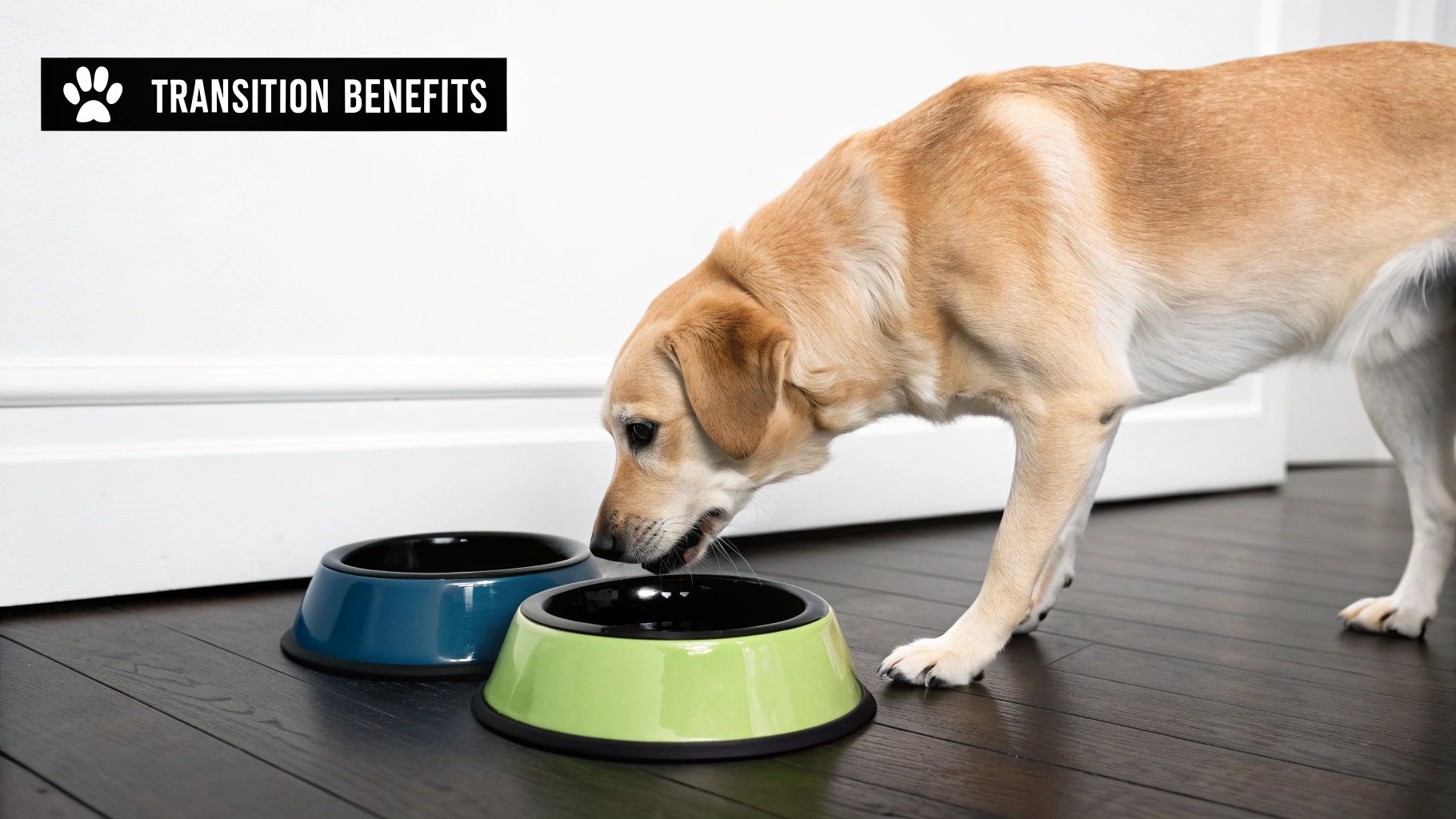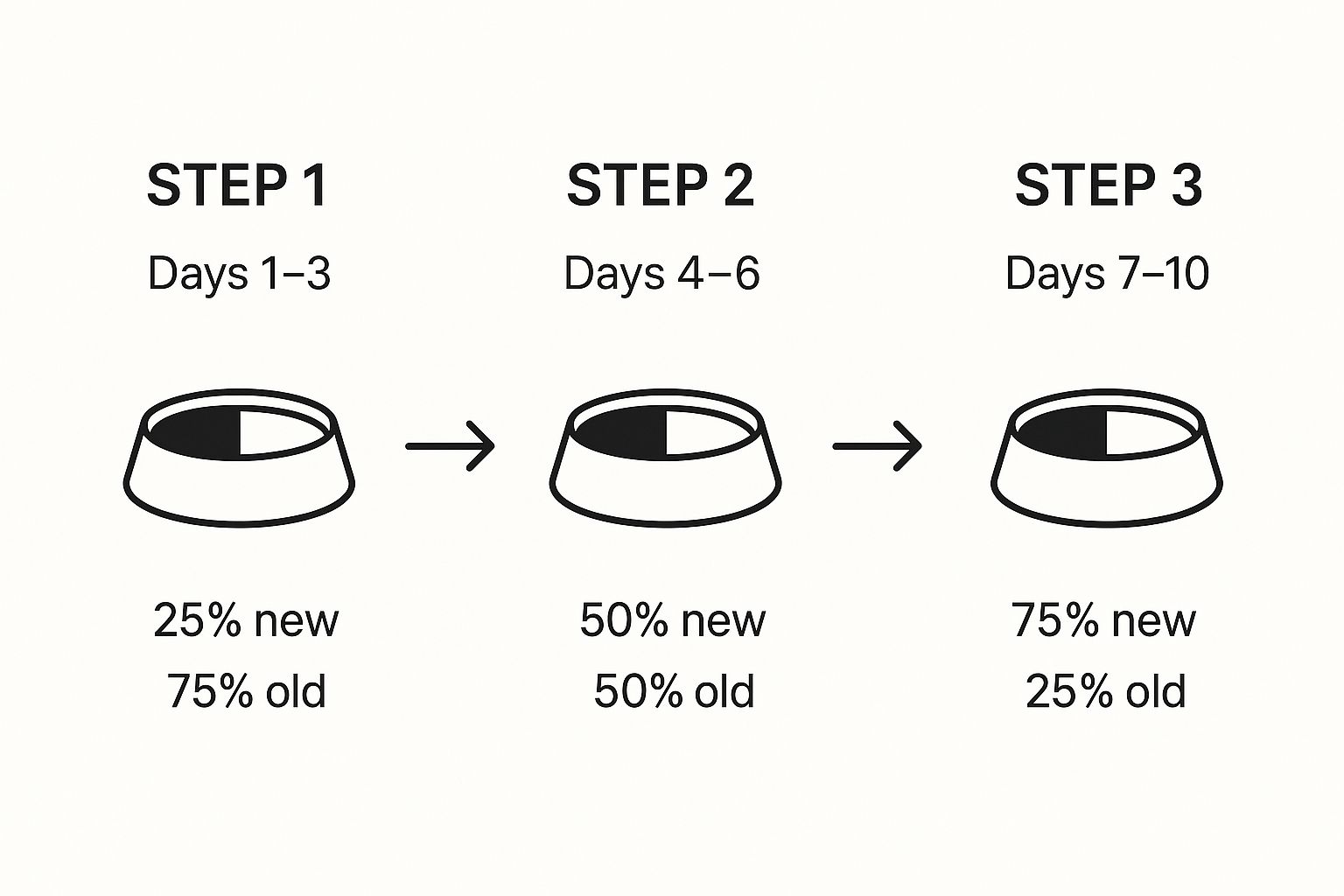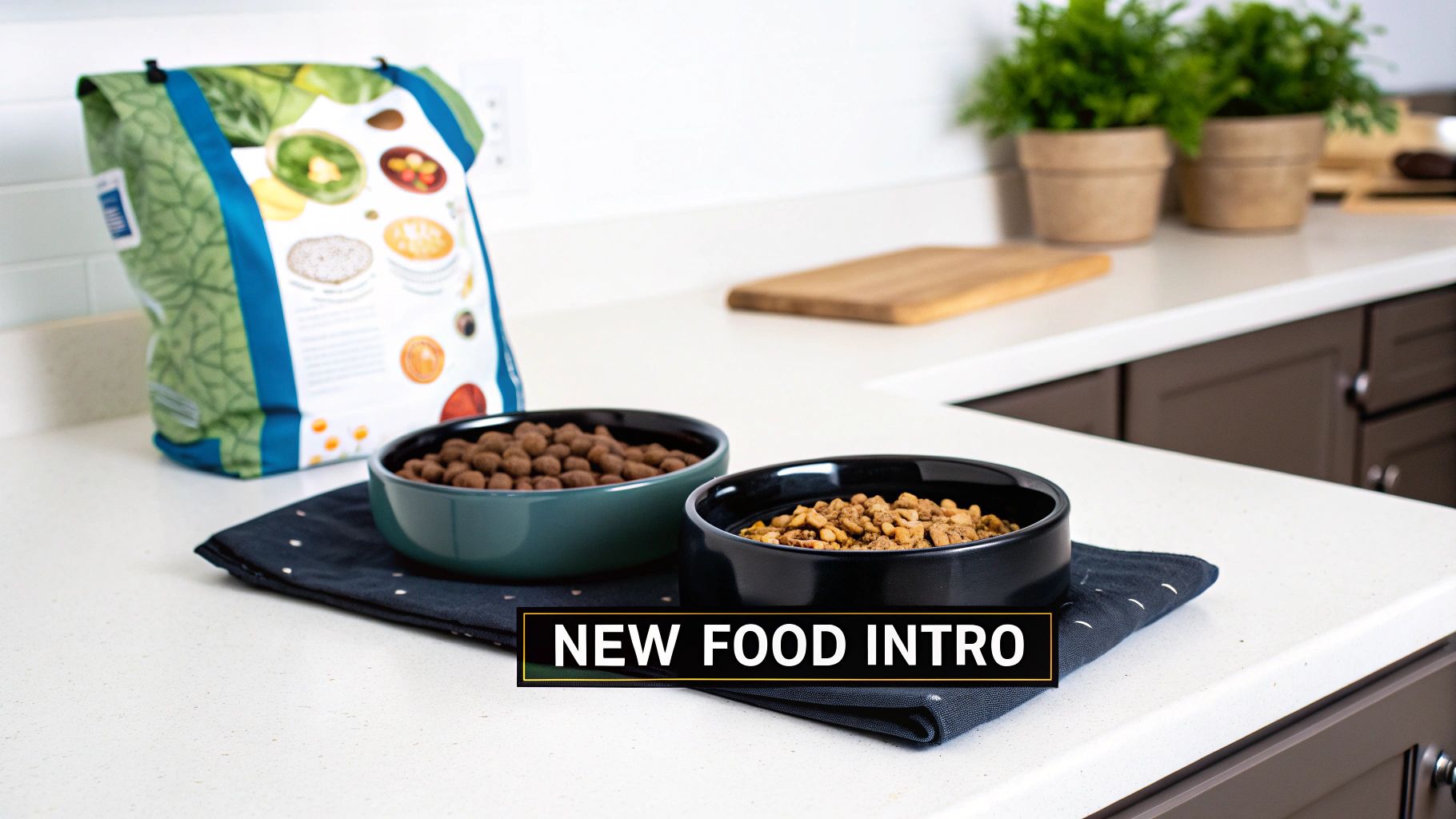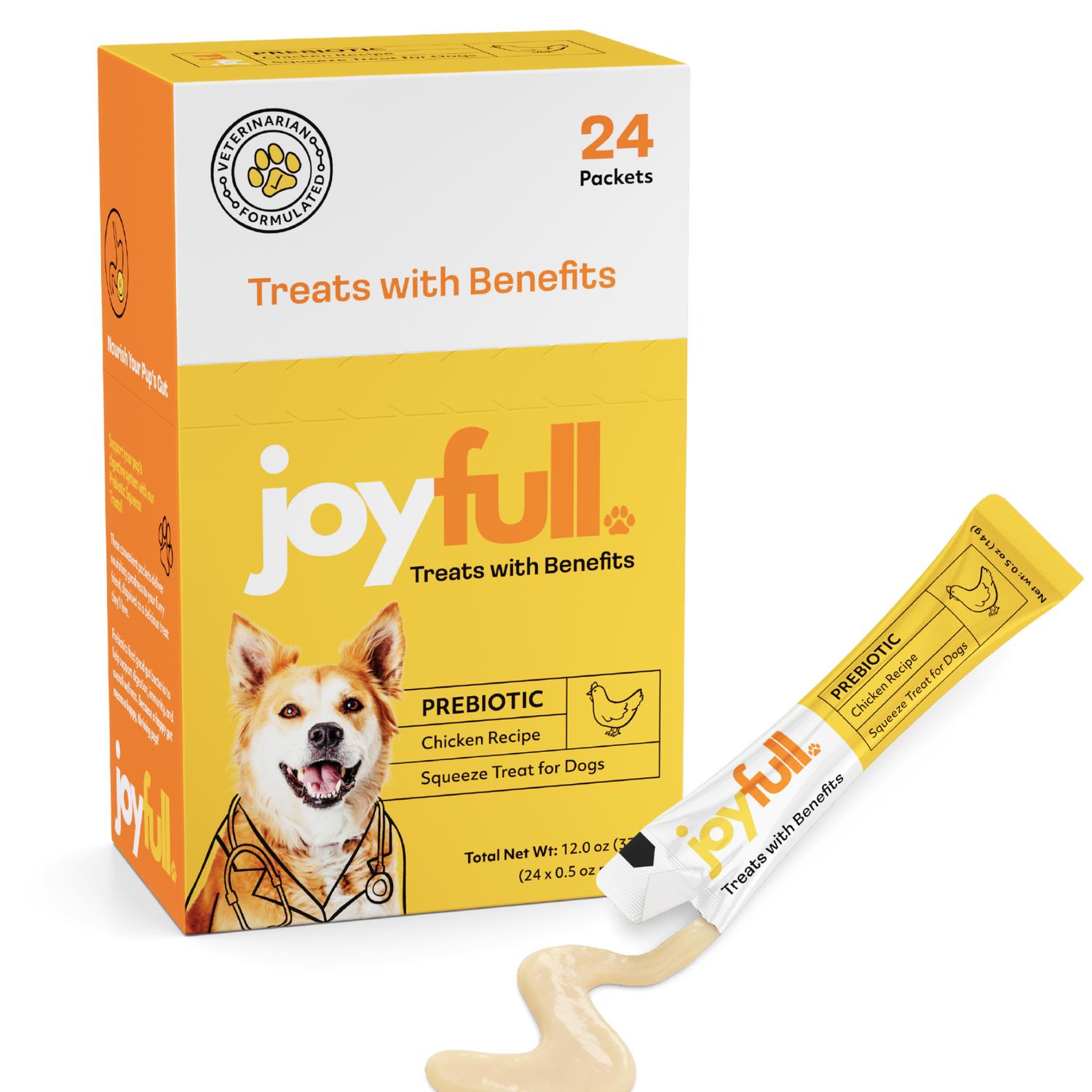
How to Transition Dog to New Food A Practical Guide
Thinking about switching your dog's food? The golden rule is simple: go slow. The secret to a happy tummy is to gradually mix the new food with their old food over 7-10 days. This methodical approach is your best bet for avoiding digestive upset and helping your pup adjust without a hitch.
Why a Slow Transition is So Important

To us, swapping one kibble for another might seem like a small change. But for your dog's digestive system, which is a creature of habit, it’s a pretty big deal. A sudden switch can easily overwhelm their gut and lead to some unpleasant results like vomiting, gas, or diarrhea.
It all comes down to biology. Your dog's gut is home to a complex community of bacteria—their microbiome—that is perfectly adapted to what they eat every day. When you suddenly introduce new ingredients, you're disrupting that delicate balance. A slow, gentle transition gives these good bacteria the time they need to adjust, which means your dog can absorb all the nutrients from their new food and stay happy and healthy.
Common Reasons for Switching Foods
Sooner or later, most of us will need to change our dog's diet. Knowing why you're making the switch often reinforces why it's so important to do it correctly.
Here are a few common scenarios I see all the time:
- Growing Up: A lanky puppy has very different nutritional needs than a full-grown adult dog or a senior. Transitioning from puppy to adult formula is one of the most common and necessary food changes.
- Health Concerns: A new diagnosis from the vet, like a food allergy or kidney disease, almost always comes with a prescription for a specialized diet.
- A Nutritional Upgrade: Sometimes, you just want to give them something better. After you learn how to read dog food labels, you might decide to move to a higher-quality food with more wholesome ingredients.
- Weight Management: If your dog needs to gain or lose a few pounds, your vet will likely recommend a food specifically formulated to help manage their weight.
A gradual transition over 7 to 10 days isn't just a suggestion—it's the gold standard recommended by veterinarians. Abrupt changes can cause gastrointestinal issues in up to 20% of dogs, which really shows why a little patience goes a long way for their well-being.
Ultimately, taking your time protects your dog's digestive health and sets them up for success with their new diet.
Quick Reference Food Transition Schedule
To make things easier, here is a simple schedule to follow. Remember, this is a general guideline—if your dog is extra sensitive, you can always extend the transition period by a few days.
| Day(s) | Old Food Ratio | New Food Ratio |
|---|---|---|
| 1-2 | 75% | 25% |
| 3-4 | 50% | 50% |
| 5-6 | 25% | 75% |
| 7+ | 0% | 100% |
This step-by-step approach gives your dog's system plenty of time to adapt, making for a much smoother and more comfortable switch for everyone involved.
Your Day-by-Day Dog Food Transition Plan
Knowing why you need to transition food slowly is one thing, but knowing how is what really matters. So, let’s get practical. I’ll walk you through a simple, effective schedule that I’ve used countless times.
For this example, let's imagine we're switching a healthy, 50-pound adult dog from their old kibble to a new one. We'll aim for a standard 10-day transition.
Just remember, this is a blueprint, not a rigid rulebook. You know your dog. If they have a sensitive stomach or a history of tummy troubles, don't be afraid to stretch each stage out for a few extra days. The goal is a happy gut, not a race to the finish line.
Days 1-3: The Gentle Introduction
The first few days are all about making a quiet first impression. We want to introduce just enough of the new food to let your dog’s digestive system get acquainted with it, without setting off any alarms.
Think of it as a small taste test. For our 50-pound dog who eats about three cups of food a day, you’ll just be swapping a small fraction.
- Old Food: 75% of the meal (about 2 ¼ cups)
- New Food: 25% of the meal (about ¾ cup)
Make sure you mix the two foods together really well. Some clever dogs will try to pick out their old favorites and leave the new stuff behind! For these first few days, your main job is to be an observer. Keep a close eye on their stool quality—you’re looking for it to stay firm. Also, watch their general disposition. Are they still happy and energetic? Eager to eat? These are all good signs.
This chart gives you a great visual of how the ratios shift over a typical 10-day period.

As you can see, it's a gradual seesaw—as the new food increases, the old food slowly fades out.
Days 4-7: Finding the Balance
If the first three days passed without a hitch, it's time to increase the new food's presence. By now, your dog's gut has been introduced to the new ingredients, and we’re asking it to get a little more comfortable.
The bowl for our 50-pound dog should now look like this:
- Old Food: 50% of the meal (about 1 ½ cups)
- New Food: 50% of the meal (about 1 ½ cups)
This 50/50 stage is often where you might see minor hiccups, like slightly softer stools. Don't panic. This is often just a temporary adjustment period. If you see this, just hold steady at this fifty-fifty ratio for an extra day or two until things firm up again before moving on.
Expert Tip: A consistent, well-formed stool is your green light to continue. If you notice persistent diarrhea, vomiting, or a total loss of appetite, it's time to pause the transition and give your vet a call.
Days 8-10: The Home Stretch
You're almost there! At this point, the new food is the star of the show, and your dog's digestive system should be well on its way to fully adapting.
For the final mix before making the complete switch, you'll serve:
- Old Food: 25% of the meal (about ¾ cup)
- New Food: 75% of the meal (about 2 ¼ cups)
After a couple of days at this ratio with everything looking good, you can confidently pour a bowl of 100% new food. Congratulations—you’ve successfully made the switch
What to Do When the Transition Hits a Snag
Even when you do everything right, sometimes a food switch doesn't go as smoothly as planned. Some dogs just have incredibly sensitive systems, and others, well, they have very strong opinions about what they'll eat.
If you hit a bump in the road, don't panic. Most of the time, these are small issues we can solve with a few simple tweaks.
What If Your Dog Is a Fussy Eater?
You mix the new food in, set the bowl down, and... nothing. Your dog might give it a tentative sniff, look at you with an expression of betrayal, and walk away. This isn't always a flat-out rejection; often, it's just suspicion of something new.
If your dog is turning their nose up, you might just need to make the new food a little more appealing. The trick is to tempt them without adding a bunch of new ingredients that could cause their own set of problems.
A few things that work wonders:
- Add a little warm water. Just a splash is enough to warm up the kibble and release its aroma, making it much more interesting. A bit of low-sodium bone broth works great, too.
- Use a tasty "topper." A spoonful of plain, canned pumpkin (the pure stuff, not pie filling!) can entice a picky eater and is fantastic for digestion.
- Try hand-feeding. Sometimes, offering a few pieces of the new kibble by hand like a treat can reframe it as a good thing in their mind. It helps build a positive connection to the new flavor.
How to Handle Minor Tummy Troubles
It's pretty normal to see slightly softer stools for a day or two as your dog's gut microbiome gets used to the new ingredients. This is usually just part of the adjustment period.
If you notice the soft stool is lasting more than a couple of days, or if your dog seems a bit gassy, that's your cue to pump the brakes. Don't push forward. Just hold at the current ratio of old-to-new food for another two or three days. This gives their system a chance to catch up and stabilize before you continue increasing the new food.
When you learn how to transition dog to new food the right way, the data is clear: you sidestep most potential issues. Studies have shown that dogs on a slow transition plan experience digestive upset only 7% of the time. Compare that to the 24% of dogs who have problems when switched over too quickly. You can dig into more market trends in dog nutrition on grandviewresearch.com.
Now, if you're seeing more serious signs like severe diarrhea, vomiting, or if your dog seems unusually tired and won't eat at all, that's different. Stop the transition immediately and go back to 100% of their old food. Then, give your vet a call. These symptoms could point to a genuine food intolerance or a separate health issue that needs a professional's attention.
What About Dogs With Special Dietary Needs?

That standard 10-day transition schedule works beautifully for most dogs, but what if your pup has a notoriously sensitive stomach, known allergies, or other specific health issues? In that case, we need to take a much more cautious and personalized approach to avoid triggering a flare-up.
If you’re nodding along because this sounds like your dog, your new best friend is patience. Forget the 10-day plan; you should be thinking more along the lines of a 14-day or even a 21-day transition. This ultra-slow method gives a delicate digestive system the time it really needs to adjust to new ingredients, which dramatically lowers the risk of an upset.
Taking It Slow for Sensitive Stomachs
For a dog with a sensitive gut, you'll want to stretch out each stage of the mixing process. Instead of increasing the new food every couple of days, you might stay at each ratio for three, four, or even five days. The whole time, you'll be on high alert, watching their stool quality and overall comfort.
This extended timeline is a game-changer when you're trying to figure out food intolerances. It gives you a much better window to see if a specific ingredient is causing trouble before you've gone all-in on the new food. This is often the case with skin issues, which can be closely linked to digestive health. You can find some great pointers in our guide to the best dog food for skin allergies.
The real key to a successful transition for a sensitive dog is observation. If you see even one day of slightly soft stool, that's your cue to pause. Hold at the current old-to-new food ratio until their system gets back to normal, even if it adds a few more days to your timeline.
Switching Between Kibble, Raw, and Fresh Food
Moving between completely different types of food—say, from dry kibble to a fresh, raw, or home-cooked diet—is a whole different ball game. These formats are worlds apart in moisture, nutrient density, and texture, and the switch requires a specialized plan.
A few things to keep in mind for these more complex changes:
- From Kibble to Fresh or Raw: A very, very slow transition is non-negotiable here. Some veterinary nutritionists actually recommend a "cold turkey" switch for certain raw diets to avoid potential bacterial issues from mixing raw and cooked foods. However, this is a risky move and should only ever be done under the direct supervision of your vet.
- Adjusting Stomach pH: The enzymes and stomach acidity required to break down kibble are different from what's needed for raw meat. A slow transition, sometimes stretching over several weeks, gives the gut time to adapt its acid production accordingly.
When you're dealing with anything beyond a simple kibble-to-kibble switch, your veterinarian is your most valuable resource. They can help you create a custom plan that considers your dog's specific health needs and ensures the change is safe and successful.
Pro Tips for a Seamless Food Switch

It's not just what’s in the bowl that matters. A few smart habits can make all the difference between a smooth transition and a week of tummy troubles. These little details help you isolate the new food as the only major change, making it easier to see how your dog is really handling it.
First, and this is a big one, pause all new treats and table scraps for now. If your dog suddenly gets an upset stomach, you need to know for sure if it’s the new kibble or that piece of cheese they snagged. Stick to their usual, trusted treats until the transition is complete.
Keep Things Consistent and Fresh
Dogs thrive on routine, and their digestive systems do too. As much as possible, keep mealtimes at the same time each day. This predictability helps their body adjust more smoothly to the new ingredients.
Don't forget about freshness, either. Make sure you seal both bags of food tightly after each use and store them in a cool, dark spot. No one likes stale food, and a dog who suddenly turns their nose up might just be reacting to off-tasting kibble, not the new formula itself.
The global dog food market is massive—valued at around USD 63.1 billion in 2024. That number shows just how much effort goes into creating specialized nutrition for our pets. It’s also why vets and food makers are so adamant about proper transition plans; they want dogs to get the full benefit of these advanced diets. You can dig into more global pet food trends on fortunebusinessinsights.com.
Once your dog is fully on the new diet, start watching for the positive signs. A glossier coat, higher energy levels, and solid, consistent poops are all clear indicators that you’ve found a great match for your furry friend.
Common Questions and Troubleshooting a Food Switch
Even with the best plan, you might hit a few bumps in the road. Let's tackle some of the most common questions I hear from fellow dog owners when they're changing up their pup's diet.
What Should I Do If My Dog Gets Severe Diarrhea?
This is a big one. If you notice severe, persistent diarrhea, any vomiting, or if your dog just seems completely wiped out and lethargic, hit the brakes on the transition immediately.
Your first move is to go back to feeding 100% of their old, familiar food. These symptoms are a clear signal that something is seriously wrong—it could be a major intolerance or even an unrelated health problem. Don't wait it out; give your veterinarian a call right away.
Do I Really Need to Transition Between Different Flavors of the Same Brand?
Yep, you absolutely do. It's a common mistake to think that if the brand is the same, you can just swap bags. But different recipes mean different protein sources, fats, and other key ingredients. A sudden switch, even between "chicken" and "beef," can easily throw your dog's digestive system for a loop.
The good news is you probably don't need a full 7-10 day transition. A quicker 3-5 day switch is usually enough to ease them into the new flavor without any tummy trouble.
Knowing what to look for in dog food is half the battle. Our guide on what to look for in dog food can help you make an informed choice for your next transition, ensuring you pick a high-quality option from the start.
How Long Does It Take to See If the New Food Is a Good Fit?
Patience is key here. You need to give the new diet some time to really show its effects, both good and bad.
Once you’re fully transitioned to the new food, wait at least four to six weeks before making a final judgment. This gives their body enough time to adjust, and you'll get a true picture of how they're doing. Look for positive signs like a healthier, shinier coat, more consistent energy, and solid, predictable poops.

